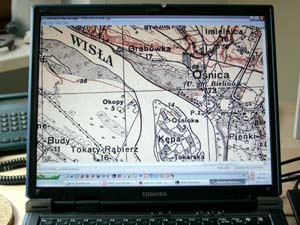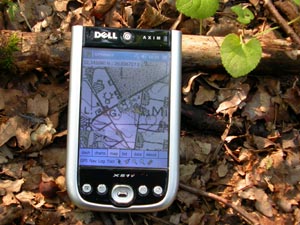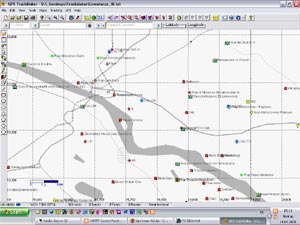 |
 |

|
Cmentarze and GPSby Jutta Dennerlein |
|
|
During my September 2007 trip to Poland, I was often reminded of a book by Daphne du Maurier: The House On The Strand (UK, 1969). In this fictitious story a new drug enables people to get "transported" to the fourteenth century, where they can walk around and witness the thrilling life of the people back then. However there is only a timely transport, not a physical. So while following their heroes in the fourteenth century, the persons who took this drug are walking in geographical accuracy in modern England where their lives are endangered by streets, cars and trains ... No, I was not drugged when I visited Poland in 2007! I only had some technical equipment with me, which enabled me to almost "walk with one foot in the past". Sharing this experience might justify a somewhat technical article. |
|
First stepsMaking use of the Global Positioning System (GPS) soon came to our mind, when we started to compare maps of different scales or maps printed in different times. It was not easy to see if a cemetery shown on a scale 1:100 000 map was the same as the one shown on a scale 1:25 000 map. A geographical mapping was necessary to decide this. So we had to find out the geographical coordinates of the cemeteries. Calculating these coordinates from the position on a map is one of the things which could be done. Locating the cemetery while standing on it was another thing and it would be much easier, more accurate and much more fun! So the first and rather simple usage we made from GPS was carrying a GPS receiver with us while we were on site and saving the geographical position for further use. This was sufficient and worked fine during phase II of the project. In this phase we were following modern maps to the cemeteries marked on them. The GPS was only used as an additional documentation facility. The next stepIn 2007 phase III of the project was started and we now also wanted to find cemeteries which were marked on old maps, but not on modern maps. There were these great scans of detailed Polish WIG maps provided by the MapyWig Project. We had viewed many of these maps to find more cemeteries to investigate. The excellent quality of the maps provided us with a large list of new research objects and gave room for the idea to use these maps also to find our research objects on site. |
|
|
Using the electronic scans of the old WIG maps to identify a rather accurate geo-position of a cemetery was possible by using a software which could calibrate the scanned maps by entering two or more known geo-positions (usually the corners of the map, which show the coordinates). By moving the cursor to a cemetery symbol on the calibrated map, the coordinates are displayed. |

Calibration of the very detailed WIG maps - Photo: Jutta Dennerlein, 2007 |
|
These calculated coordinates should enable us to find the cemetery by using a GPS receiver while we were on site. How accurate would this method be?The original maps were 80 years old and already heavily used when they were scanned. Some scanners create distortions which will lead to a wrong result. Most projection methods create maps which loose parts of their scale conformity at their fringes. We checked the quality of our calibration with the known coordinates of the cemeteries we visited in phase II. The result was disappointing. The inaccuracy in some cases turned out to be more than 150 meters. No chance to find a hidden cemetery this way! But we still trusted the quality of the Polish WIG maps. We assumed that the bad results were caused by using calibration points at the extreme border areas of the maps. So we made a new calibration of the maps, this time using cemeteries and their known positions for the calibration and others of the cemeteries of phase II to check our calibration. This time the result was great! The inaccuracy seemed to be less than 10 meters! We were lucky that we had already taken the positions of the cemeteries we had visited. And we were lucky that we had decided to use a software which was able to use more than two points for calibration. The known cemeteries were located in very different areas of the maps and helped to get very good results for these areas. But we wanted more!The very detailed maps created the desire to have these old maps with us on site. It would be much easier to find a cemetery following country lanes, than it would be following instructions like "distance 500 meters, steer NNW". It would also be great if we could make an on-the-fly calibration of maps for areas which we had not visited before. So some more equipment was needed: a portable, small, high-resolution display and a software to display the calibrated maps and handle the communication with the GPS. A 'normal' car navigation system would not do - even if you can take it out of the car - since they usually support only vector based maps. |
|
|
But carrying our mobile computer around in the lilac bushes (together with a GPS receiver, a camera, replacement batteries, additional storage cards, paper, pencil, a pair of pruning shears, a brush and a flashlight) was not a very promising prospect. So a combination of a PDA (Personal Digital Assistant) with a Bluetooth connection to the GPS receiver was chosen. As software running on the PDA we used GPSdash2 |

PDA and wireless connection to the GPS receiver. |
Did it work?It worked like a charm! We had only hoped for some additional assistance in finding some of the most intractable cemeteries. But what we got was an all-round system! Going by car or hiking, the display showed the actual position on the old map with surprising accuracy. Stopping at old churches and adding a new calibration point had soon become second nature. So the quality of our calibration improved constantly. While driving in the car, the position mark on the display followed exactly the old road (if it had not been replaced by a new road). To get as near as possible to a cemetery we just had to pick the country lane which the old map indicated. To our surprise the unpaved country lanes and sand roads had not changed since 1930. Driving with the old maps on display in the car had not been planed. But it soon became a habit to keep one eye at the world how it had been in 1930 while driving through modern Poland. How easy it was to see, if a house had already been there in 1930. How easy to find the place, where the old Lutheran churches in Iłów or Gąbin had been. How easy to see if the embankment had changed within the last 80 years. The difficulty was, not to become a traffic risk while lingering in the past. The processing of the results |
|
|
Besides storing the correct positions of the cemeteries in our database, it was now possible to create a vector based map for our research objects - the visited ones and the prospects. This map will also help to keep track of the status of the cemeteries, to avoid duplicates and it will help to plan research tours. As software for the creation of vector based maps we used |

Vector based map with our research objects |
Some scruplesA general question rises again and again in every phase of the project and should be discussed here. The Cmentarze Project is pointing the attention of many different people to the cemeteries. This is one of the goals of the project. But is it really clever to make descriptions how to find a cemetery or to give an exact geo-position for it? The cemeteries already have experienced vandalism, violation of graves and grave robbery out of different motives. Not everybody who is visiting a cemetery is leaving it as it has been before (not even family researchers). Aren't we supporting these kinds of unwanted activities by making it easy to find a cemetery? There has never been an easy answer to this question. But we always decided to keep going with the project as we had started it. The attention for the cemeteries which we create as well as the information we publish about them is also protecting the cemeteries. The attention, the awareness and the interest of people living near by the cemeteries or people interested in restoring Polish history are currently their most effective and unfortunately their only protection. |
|
|
Jutta Dennerlein, April 2008 |
|